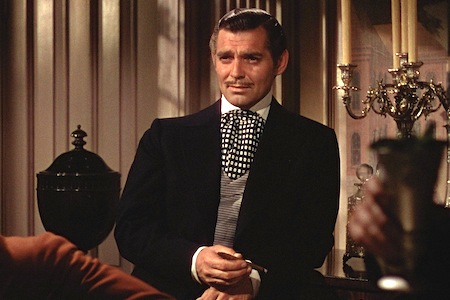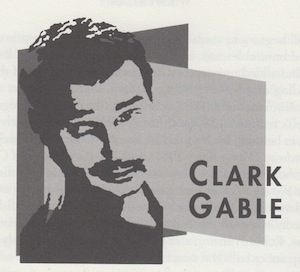Born: February 1, 1901, Cadiz, OH
Died: November 16, 1960, Hollywood, CA
Gable was Gable in film after film. That was the foundation on which stardom was built then.
—Marsha Hunt
Clark Gable first achieved fame on Broadway before a string of bit parts in silent films landed him The Merry Widow (1925). A speaking part in one of the first sound westerns, The Painted Desert (1931), made Louis B. Mayer take notice of the handsome actor, and Gable soon signed a lucrative MGM contract. (Viagra) He would remain their hottest property for more than thirty-five years. His blue-collar charm and mustachioed smile combined to create a dashing rogue whose rough exterior could not tarnish his inherent good nature. Crowned the “king of Hollywood,” he molded the public’s ideal of the leading man in more than sixty films.
MGM put him through romantic paces with Greta Garbo in Susan Lenox: Her Fall and Rise (1931), Joan Crawford in The Possessed (1931) and Jean Harlow in Red Dust (1932). Because several other actors in Hollywood were experiencing great success with gangster films, Mayer decided Gable should pick up a tommy gun. These roles irked Gable, who felt that they would stereotype him and ultimately ruin his career. He complained to Mayer, viciously attacking the studio head for playing puppetmaster with his career. Mayer retaliated by lending Gable out to Columbia for light comedies. The famous tiff put Gable in the hands of director Frank Capra, whose It Happened One Night (1934) swept all of the main Oscar categories, winning five, and put Gable firmly on top.
Clark Gable was an unlikely fellow to become a movie star. His legendary ears were initially considered too big, his speech was at first fast-paced and clipped and producer Darryl Zanuck once stated that “he looks like an ape.” But next to a variety of glamorous leading ladies, he remained confident and in charge. He was witty and handled physical comedy as well as he handled romance. He was what every woman wanted and every man wanted to be.
Back at MGM, Gable switched easily to bare-chested adventure in Mutiny on the Bounty (1935), another Oscar-winner that crystallized his image of male virility. Vehicles were created to capture the genuine camaraderie he shared with fellow actors; he was paired with Spencer Tracy for San Francisco (1936) and Boom Town (1940). Because of his overwhelming appeal, there was worldwide speculation that Gable would be cast as Rhett Butler in Gone with the Wind (1939); it had been reported in the gossip magazines that Gable was ideal among readers of the Margaret Mitchell novel. As extensive tests were held for a proper Scarlett, producer David O. Selznick tried to woo Gable for the role of the southern gentleman. Gable wasn’t interested, so Selznick floated Gary Cooper’s name to the trades, testing the waters. But public demand was unyielding—the fans wanted Gable—and reluctantly he gave in. Gone with the Wind would give him the role of a lifetime and supplied him with the most memorable line of dialogue in Hollywood’s golden era when he told Scarlett, “Frankly, my dear, I don’t give a damn.” The force of his personality helped the film become an instant classic and one of the box office champions of all time.
Steady profits rolled in from his films throughout the 1930s, but Gable’s stardom lost all meaning to him when his new bride, actress Carole Lombard, became an early casualty of World War II. Just before boarding the plane that crashed, killing all aboard, she had encouraged Gable to enlist in the war effort. After her funeral, he immediately left the movies for combat service. It was another indication of the strong moral character Gable displayed both on and off the screen. When he was later asked to play a role in a war drama, he refused because of a subplot involving an adulteress. “I won’t play a man who sleeps with a woman whose serviceman husband is overseas,” stated Gable.
After his return to Hollywood, he played macho roles in Mogambo (1953) and Run Silent, Run Deep (1958). In the early fifties, he attempted an independent production venture, but his failing health made the task impossible. After three decades as Hollywood’s male lead, Gable romanced Marilyn Monroe in John Huston’s The Misfits (1961) before succumbing to a heart condition two weeks after filming was completed.
To read all the republished articles from ‘The Film 100,’ go to Reintroducing the Film 100 here on Keyframe.





